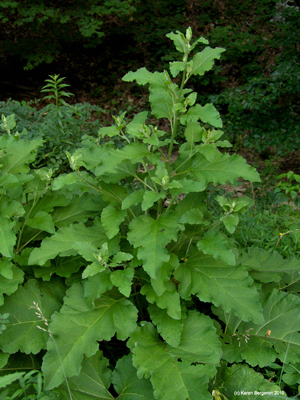Arctium lappa
| See Also | Botanical Monographs |
|---|
Burdock is known for its ability to heal a number of skin conditions, yet it also has many other uses. To explore the characteristics, medicinal uses and prescribing considerations of this herb in more detail, check out the references indicated. [1] [2]
Contents
Characteristics
- Common Names: Great Burdock, Gobo, Burr burr, Lappa, Bardana, Thorny burr, Begger's buttons, Bardane, Snake's rhubarb, Niu bang zi
- Species Used: A. lappa, similar species are A. minus, A. tomentosum
- Family: Compositae/Asteraceae
- Habitat: Arctium is an introduced European plant that grows along roadsides, pastures and in abandoned lots.
- Parts Used: Primarily the roots/ rhizomes, but also the leaves (poultice) and seeds (TCM)
- Description: Arctium lappa is a biennial thistle that may grow 2-6 feet tall. A large brownish-gray taproot supports the plant and gives rise to the stem. Large egg or heart-shaped leaves have a thin, woolly down on their undersurfaces. Flowers are purple with a calyx of scales with hooks.
- Active constituents: inulin, polyacetylenes, volatile oil, arctiopicrin
- Medicinal Actions:
- Roots: alterative, digestive bitter, cholagogue, diuretic, diaphoretic, antipyretic, diuretic depurative, phtyoestrogenic, antirheumatic, laxative, antimicrobial, hypoglycaemic, demulcent, antitumour, antimutagenic
- Leaves: alterative, vulnerary (poultice), antimicrobial, antibacterial, antifungal
- Seeds: alterative, diuretic, urinary tonic, vulnerary
Uses
Historical Uses:
In Japan Arctium is known as Gobo and has been used as food for about 1,000 years after Buddhist monks brought the plant into the country. They used the root to cure such things as constipation and mercury poisoning and the leaves externally to heal rashes and burns. Today many Japanese as well as Europeans use Arctium as food and medicine. In Europe during the world wars Arctium was used as a treatment for wounds. Pilgrims brought A. lappa over to North America and native Americans quickly added the plant to their herbal repertories for its blood purifying abilities, as a kidney tonic and also to increase concentration. It has also been historically used to treat hair loss. In Western herbalism, burdock is condsidered an important alterative herb. Is was used as a detoxifying agent to "cleanse" the blood, removing toxins from the body. It was used both internally and externally for many conditions of the skin, such as acne, boils, abscesses, and eczema and for situations of chronic inflammation, such as rheumatism and gout.
Medicinal Uses:
- Arctium has anti-inflammatory effects and is used adjunctively to treat rheumatic arthritis.
- May decrease blood sugar levels.
- Arctium is considered to be an anti-mutagen and is added to anti-cancer formulas (such as Essiac or Hoxsey formulae) because it stimulates white blood cells. However, Arctium should not be used alone for this purpose.
Prescribing Considerations
The information provided is intended to augment the treatment from a naturopathic doctor or other trained medical professional. Although most herbs are generally safe, it is recommended that you avoid self-prescribing especially when there is an underlying ongoing medical condition, if you are on any prescription medications or if you are pregnant or breastfeeding.
Internal
- Dried root: 2-6 g of dried root, or decoction, three times daily
- Liquid extract: (1:1 in 25% alcohol): 2-6 ml three times a day
- Tincture: (1:10 in 45% alcohol): 8-12 ml three times a day
- Decoction: 1 part in 20, 500 ml per day
External
- An infusion or tincture (1:5 in 25% alcohol) of the leaf can be used externally as a poultice
Safety
The safety and prescribing considerations for Burdock include:[3], [4]
- Generally regarded as safe.
- Side effects can include allergic reactions especially in those people that have an allergy to the members of the Asteraceae family (ragweed, chrysanthemums, marigold and daisies). It may temporarily worsen symptoms because of the detoxifying action.
- Caution: Pregnancy and Diabetes.
- Drug-Herb Interactions:
- Diabetic Medication - Herb may interact with drug as it has a blood sugar lowering effect.
References
- ↑ Boon Heather, Smith Michael (2009) 55 Most Common Medicinal Herbs: The Complete Natural Medicine Guide Second Edition Institute of Naturopathic Education and Research, CCNM Toronto.
- ↑ Godfrey Anthony, Saunders Paul, Barlow Kerry, Gowan Matt (2011) Principles and Practices of Naturopathic Botanical Medicine, Advanced Botanical Medicine. V3 CCNM Press, Toronto.
- ↑ Stargrove Mitchell Bebell, Treasure Jonathan, McKee Dwight L (2008) Herb, Nutrient and Drug Interactions: Clinical Implications and Therapeutic Strategies.
- ↑ Brinker Francis (1997) Herbal Contraindications and Drug Interactions: Plus Herbal Adjuncts With Medicines, 4th Edition Eclectic Medical Publications.
